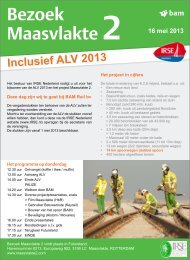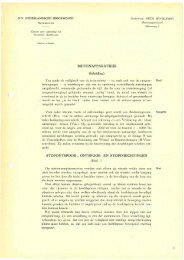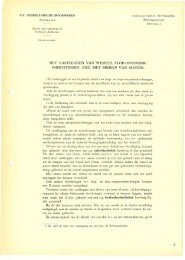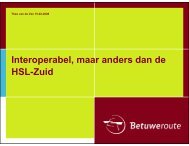intermittent and continuous ATP 101119 - irse.nl
intermittent and continuous ATP 101119 - irse.nl
intermittent and continuous ATP 101119 - irse.nl
- No tags were found...
Create successful ePaper yourself
Turn your PDF publications into a flip-book with our unique Google optimized e-Paper software.
affordable at all. In literature, e.g. [26] SIL levels specified for <strong>intermittent</strong> systems arequoted as SIL 2.Intermittent Systems.Intermittent systems resemble train stop systems to the extent that information iso<strong>nl</strong>y passed “<strong>intermittent</strong>ly” from track to train at certain fixed locations. Most systemsof earlier design can therefore o<strong>nl</strong>y provide <strong>intermittent</strong> supervision as well, e.g.between distant <strong>and</strong> main signals <strong>and</strong> thus will o<strong>nl</strong>y provide protection against asignal being passed at danger. However as technology evolved they became morecapable <strong>and</strong> nowadays most modern systems are able to provide <strong>continuous</strong>supervision / protection of the train <strong>and</strong> can even offer (<strong>continuous</strong>) speedsupervision.Simple <strong>ATP</strong> systems such as the German INDUSI, or AWS <strong>and</strong> TPWS in the UKoperate in background mode <strong>and</strong> no indication is given to the driver, except perhapson system health or when an emergency brake application has occurred. The driverhas to observe the line side signals <strong>and</strong> react according to their aspects. O<strong>nl</strong>y in thecase of a driver driving too fast or SPADding will the system automatically apply theemergency brake. The same safety design philosophy as mentioned above for thetrain stop system are applicable.More sophisticated <strong>intermittent</strong> <strong>ATP</strong> systems, for example the British <strong>ATP</strong>systems, Dutch ATB NG, Ebicab, or indeed ERTMS/ETCS level 1, are also based onprinciple that the driver is still primarily responsible for observing signals <strong>and</strong>operating the train. The <strong>ATP</strong> still acts as a safety net. However, as newer technologyallows more information to be transmitted, some indications can be given to thedriver, for example target speed <strong>and</strong> the distance to go, i.e. to the point at which thetrain’s speed must be under the new target speed limit, or the distance to the signalat danger. As wrong indications could mislead the driver <strong>and</strong> so provoke unsafereactions, the system, or at the very minimum its speed supervision sub-system, hasto be fail-safe in this respect. Data generation, data transmission <strong>and</strong> data evaluationon board have to have a high level of safety integrity as well, as a failure could causea dangerous situation with a driver relying on the cab display rather than on the lineside signals.In general the in-can signalling allows the driver to optimise his driving <strong>and</strong>certai<strong>nl</strong>y provides a level of “comfort”, e.g. when driving in adverse weatherconditions affecting visibility of signals.Continuous SystemsContinuous <strong>ATP</strong>/ATC systems normally provide full cab signalling, which impliesthat the driver must be able to fully rely on the safety of the system. There are twoprinciples in use, which differ in safety philosophy. In France, the TVM system has avital display to the driver, the driver himself is considered fail-safe, therefore there areless technical safety requirements on the implementation of the speed supervision<strong>and</strong> emergency brake application functions. In contrary, among others, the DutchATB <strong>and</strong> German LZB employ a non-vital cab display but implement a vital speedsupervision <strong>and</strong> access to the emergency brake. In this philosophy the driver isconsidered a non-vital part of the overall train control system <strong>and</strong> even if he weremisled by the cab signal, the speed supervision <strong>and</strong> brake application will intervenein a fail-safe manner.4
















